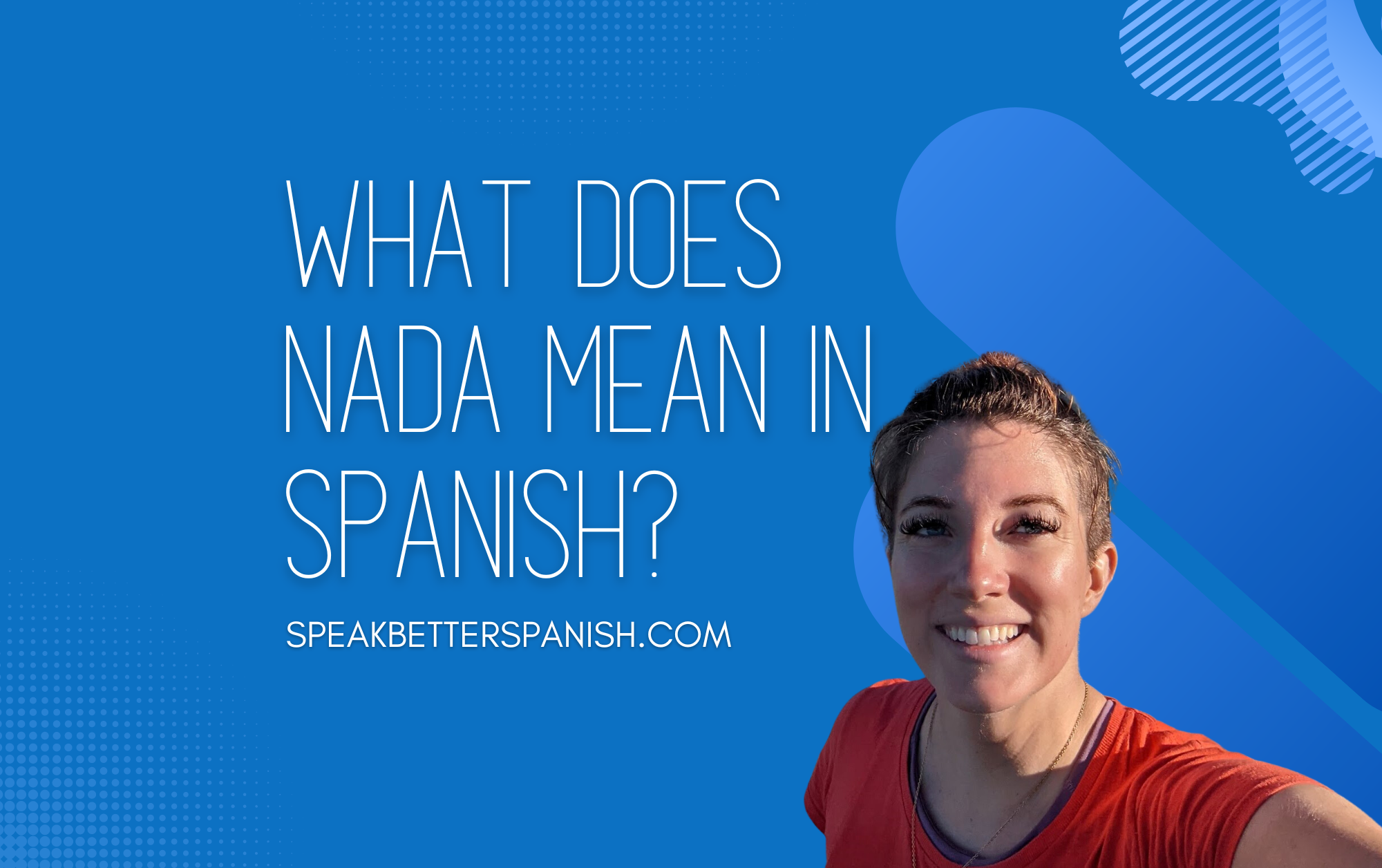Nada Que Ver: Its Meaning and Intriguing Cultural Significance
In the vibrant tapestry of Spanish language and culture, there’s a phrase that has captured hearts and minds for centuries: “Nada que ver.” But what does it truly mean? Join us as we unravel the enigmatic layers of this popular expression and delve into its fascinating history, cultural significance, and hidden secrets.
Personal Experience and Insight
As a language enthusiast, I’ve often encountered “nada que ver” in everyday conversations. Initially, its meaning seemed elusive, like a puzzle begging to be solved. But as I immersed myself in the language, I discovered a world of nuances and interpretations that went far beyond the literal translation of “nothing to see.”
One day, while chatting with a local shopkeeper in Madrid, I asked for directions to the nearest market. With a dismissive wave of her hand, she replied, “Nada que ver.” At first, I was confused. What did she mean? Were there no markets nearby? Or was she simply saying there was nothing interesting to see around?
As I continued to converse with her, I realized that “nada que ver” was not just a negative expression but also a way to convey disapproval or lack of connection. In that moment, I understood that this simple phrase could express volumes about a person’s thoughts and feelings.

Nada que ver #21 – El retrato – Nada que ver – Source pod.pe
Myth and Metaphor
The phrase “nada que ver” has its roots deep in Spanish history and culture. Some believe it originated in the Middle Ages, when people used to compare the appearance of two individuals or things and conclude that they were “nothing to see.” Over time, the phrase evolved to encompass a broader range of meanings beyond physical characteristics.
In modern-day Spain, “nada que ver” has become a versatile tool for conveying emotions, opinions, and even cultural values. It can be used to express disagreement, disapproval, or indifference. In some cases, it can also be a way to downplay the importance of something or to dismiss it as irrelevant.

7 Uses of Nada in Spanish: How to Say Nothing in Spanish? – Speak – Source speakbetterspanish.com
Facts and Figures
The phrase “nada que ver” is widely used throughout Spain and Latin America. According to the Royal Spanish Academy, it is a colloquial expression that means “there is no relationship” or “it has nothing to do with.” However, its usage and interpretation can vary slightly depending on the region.
In some countries, such as Mexico, “nada que ver” is often used in a humorous way to add a touch of irony or sarcasm to a situation. In others, such as Colombia, it can be used to express disbelief or surprise.

Cuánto cabrón / Nada que ver – Source www.cuantocabron.com
Hidden Meanings and Cultural Significance
Beyond its literal meaning, “nada que ver” holds a profound cultural significance. It reflects the Spanish tendency to prioritize emotions and relationships over logic and reason. In a culture where personal connections are highly valued, disagreement or lack of affinity can be expressed through this simple yet powerful phrase.
Furthermore, “nada que ver” embodies the Spanish concept of “duende,” which refers to a mysterious and elusive quality that can be found in art, music, and dance. This quality is often associated with passion, spontaneity, and a deep connection to one’s emotions.
![[ MEMEDEPORTES ] Nada que ver por aquí... [ MEMEDEPORTES ] Nada que ver por aquí...](https://statics.memondo.com/p/s1/mmds/2023/01/MMD_1179505_99da7064c5cd40b6912ba5aee0ba5453_futbol_nada_que_ver_por_aqui_1_thumb_fb.jpg?cb=2514915)
[ MEMEDEPORTES ] Nada que ver por aquí… – Source www.memedeportes.com
Cultural Importance and Recommendations
“Nada que ver” is an essential part of the Spanish language and culture. It is a phrase that expresses a wide range of emotions, opinions, and cultural values. To fully appreciate the beauty and depth of the Spanish language, it is important to understand the nuances of this enigmatic expression.
If you’re planning a trip to a Spanish-speaking country, be prepared to encounter “nada que ver” in various contexts. Embrace its cultural significance and use it as an opportunity to connect with the local people and gain a deeper understanding of their way of thinking and feeling.

Xa á venda as entradas para a estrea de “Nada que ver”, o documental – Source cuacfm.org
A Deeper Look into the Phrase’s Etymology
Etymology of “Nada Que Ver”
To fully comprehend the meaning of “nada que ver,” it’s essential to delve into its etymology. The phrase consists of three words: “nada” (nothing), “que” (which), and “ver” (to see). Literally translated, it means “nothing to see.” However, the phrase’s meaning extends far beyond its literal interpretation.
The word “nada” comes from the Latin “nihil,” meaning “nothing.” In Spanish, it is used to express negation or absence. The word “que” is a conjunction that introduces a dependent clause. In this case, it connects “nada” to the verb “ver,” which means “to see.” The verb “ver” is derived from the Latin “videre,” which means “to look at” or “to perceive.”

De Nada Meaning: What Does De Nada Mean? • 7ESL – Source 7esl.com
Tips for Using “Nada Que Ver” in Context
To effectively use “nada que ver” in conversations, it’s crucial to consider its context and tone. Here are a few tips to guide you:
Use the phrase to express disagreement or disapproval. When you want to convey that you don’t agree with someone’s opinion or behavior, “nada que ver” can be an effective way to do so. Just be mindful of the tone you use, as it can sometimes come across as dismissive or confrontational.

Ver Nada Que Ver (2023) Online – CUEVANA 3 – Source cuevana3.rs
Nada Que Ver: A Phrase with Many Layers
“Nada que ver” is a versatile phrase that can convey a wide range of emotions and meanings. It can be used to express disagreement, disapproval, or indifference. It can also be used to downplay the importance of something or to dismiss it as irrelevant.
The phrase is deeply rooted in Spanish history and culture. It reflects the Spanish tendency to prioritize emotions and relationships over logic and reason.

NTR de Venganza – español – Capitulo 1.10 – ¡Ella no tiene nada que ver – Source mangaxico.com
Fun Facts About “Nada Que Ver”
Here are some interesting fun facts about the phrase “nada que ver”:
The phrase is often used in a humorous way to add a touch of irony or sarcasm to a situation.
In some Spanish-speaking countries, such as Mexico, “nada que ver” is commonly used as a way to express disbelief or surprise.
The phrase has been used in popular culture, including in movies, TV shows, and songs.

Nada que ver – Podcasts – Yoors – Source yoo.rs
How to Use “Nada Que Ver” in a Sentence
Here are a few examples of how to use “nada que ver” in a sentence:
“No estoy de acuerdo contigo. Nada que ver.”
(I don’t agree with you. Nothing to see.)
“Esa película es muy mala. Nada que ver.”
(That movie is very bad. Nothing to see.)

NADA QUE VER (The Last Show) + METALL FORT – La Deskomunal – Source ladeskomunal.coop
What if You Hear “Nada Que Ver”?
If you hear someone say “nada que ver,” it’s important to pay attention to the context and tone of the conversation.
If the person is using the phrase to express disagreement or disapproval, it’s best to respect their opinion and avoid arguing with them.
If the person is using the phrase in a humorous way, you can laugh along and join in on the fun.
Listicle: 5 Ways to Use “Nada Que Ver”
Here are five ways to use “nada que ver” in a sentence:
- To express disagreement or disapproval
- To downplay the importance of something
- To dismiss something as irrelevant
- To add a touch of irony or sarcasm
- To express disbelief or surprise
By understanding the different ways to use “nada que ver,” you can effectively communicate your thoughts and feelings in Spanish.
Question and Answer
Q: What does “nada que ver” mean?
A: “Nada que ver” literally means “nothing to see” in Spanish. However, it is often used to express disagreement, disapproval, or indifference.
Q: How is “nada que ver” used in everyday conversation?
A: “Nada que ver” can be used in a variety of ways in everyday conversation, including to express disagreement, to downplay the importance of something, or to dismiss something as irrelevant.
Q: Is there a difference between “nada que ver” and “no tiene nada que ver”?
A: “Nada que ver” and “no tiene nada que ver” mean the same thing. However, “no tiene nada que ver” is more formal and is typically used in written Spanish.
Q: Can “nada que ver” be used in a humorous way?
A: Yes, “nada que ver” can be used in a humorous way to add a touch of irony or sarcasm to a situation.
Conclusion of Nada Que Ver: Exploring The Meaning Behind The Popular Spanish Phrase
<